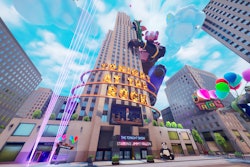The 23rd Winter Olympic Games in Pyeongchang, South Korea, came to a close on February 25 with a high-tech spectacle of a closing ceremony that featured a drone light show from Olympic sponsor Intel. But Intel wasn't the only brand to activate at the games throughout its two-week duration. Sponsors such as Coca-Cola, Samsung, Visa, and Bridgestone engaged with athletes, fans, and locals through onsite activations that offered both new and returning interactive experiences.
Here's a look at how Olympic sponsors and team sponsors engaged with attendees and supported athletes with social media-friendly photo ops, VR experiences, branded exhibits, pin trading, food, and more throughout the games.
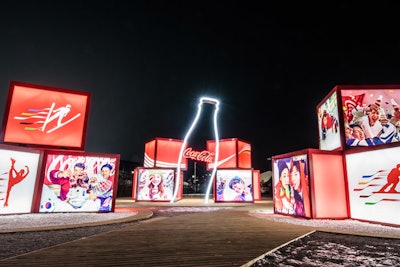
Coca-Cola’s gallery space served as a popular photo op area in the Pyeongchang Olympic Plaza. The space combined brand images with Olympic-inspired illustrations depicting Winter Olympic events.
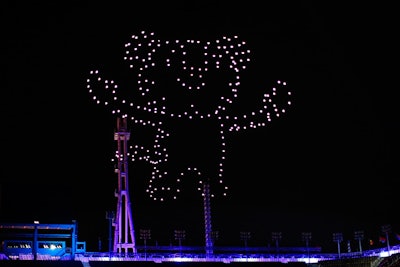
Following its Guinness World Record-breaking drone light show at the opening ceremony, Intel brought back the performance at the closing ceremony on February 25. The live 300-drone performance featured creative light illustrations in the sky, including the Olympics mascot Soohorang, a white tiger.
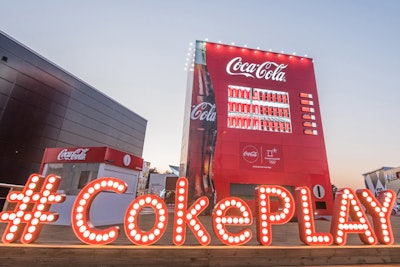
Olympic partner Coca-Cola activated a massive vending machine in front of Gangneung Olympic Park Hockey Center for the duration of the Games. The public activation, which featured a marquee-style hashtag sign, was the site of product sampling events and giveaways of Coca-Cola products, photo ops, and a heating square. The heating square consisted of 8 outdoor patio heaters, each equipped with a 360-degree camera capable of taking photos, which people could upload through the Coke Play mobile app. Momentum Korea produced all of Coca-Cola’s experiential programs in Pyeongchang.
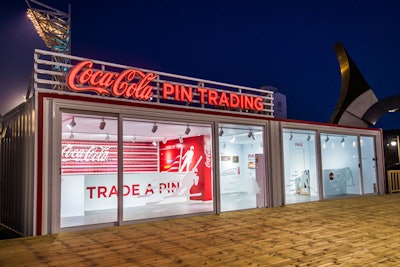
As pin trading is a distinctive cultural experience at the Olympics, Coca-Cola hosted a branded pin trading activation in Gangneung Olympic Park. The activation invited people to trade pins and also featured an exhibition of Coca-Cola Olympic pins from previous games.
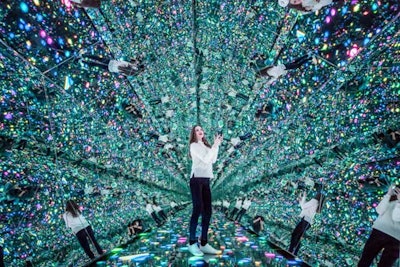
South Korea-based Samsung offered nine showcases at different locations in Pyeongchang and Gangneung throughout the duration of the games. Located in transparent structures, the showcases featured a combination of technological, cultural, and immersive fan experiences. One of the showcase highlights was the Infinity Moment—a mirrored room that responded to and integrated artwork created by visitors with a Galaxy Note8 and S Pen.
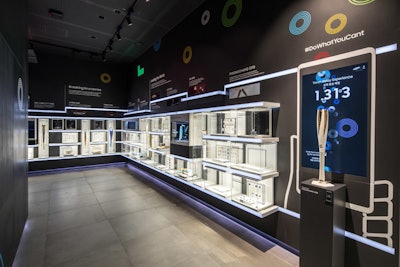
The brand’s Olympic Heritage exhibition presented its history of Olympic sponsorship, which began in 1988. The chronological exhibit featured products from past Olympic campaigns, leading up to an interactive torch for Pyeongchang, which would light up when grabbed by a guest. The exhibit also incorporated the brand’s hashtag from its Do What You Can’t campaign.
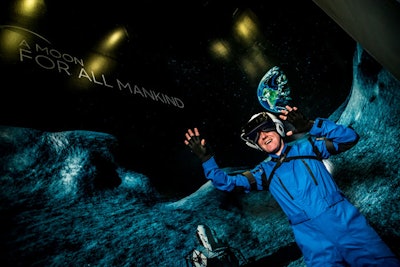
Immersive virtual-reality experiences included the debut of Samsung’s “Mission to Space VR: A Moon for All Mankind.” Visitors could participate in a space mission that included a mission briefing, trying on real training suits and helmets, and the virtual experience in a moon rig where they could feel the effect of lunar gravity.
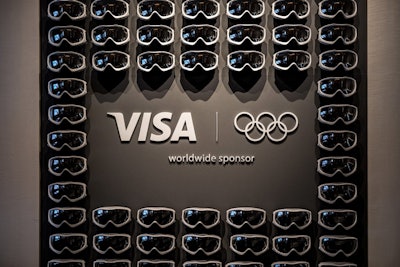
Visa’s lounge at the Seamarq Hotel hosted client and employee events and also debuted three wearable payment devices. The lounge, which was produced by Shiraz Events, featured a wall decorated with ski goggles.
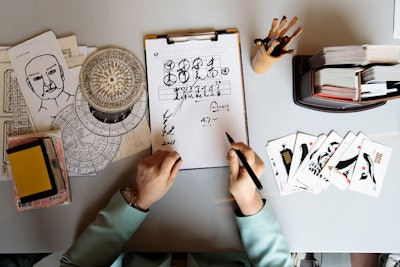
Activities for guests included readings from a fortune teller.
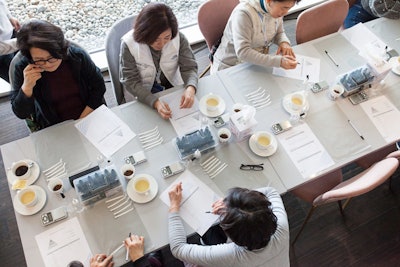
The lounge also offered a perfume-blending workshop.

Catering highlights from the hotel included a live cooking station and desserts with Visa branding.
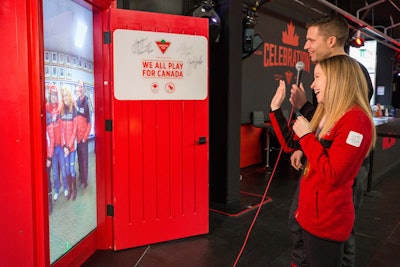
Canadian Tire, a national partner of Canada’s Olympic team, brought back its Red Door activation, which debuted at the Rio Olympics in 2016. Part of the brand’s We All Play for Canada Olympic campaign, the life-size physical door offers a live stream interaction that connects friends and fans in Canada with Olympians and Paralympians in Pyeongchang. Wondermakr produced the activation.
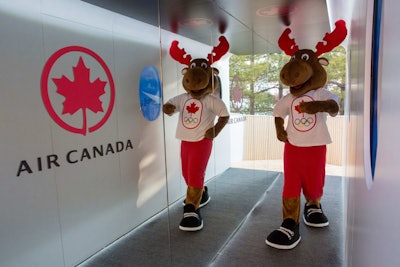
Canada Olympic team sponsor Air Canada’s Canada Olympic House was open to the public for the first time in Pyeongchang. Guests entered the area through a fuselage tunnel simulating the interior of an airplane, which also featured digital window displays of the airline’s destinations. Wondermakr created the tunnel’s digital effects, while Juiceworks Exhibits fabricated the tunnel. The activation was managed by full-service culture-centric agency Wasserman.
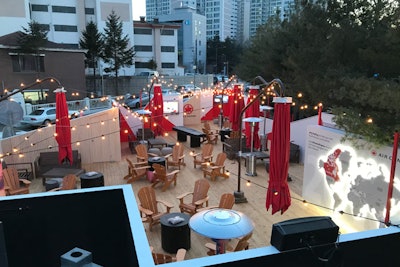
Following the tunnel, guests could step outside to a Canadian cottage-inspired space that had fire pits, Muskoka chairs, interactive games, and an Air Canada Route Map. Guests were invited to place a magnetic pin on the map to mark where they were visiting from, and in return received a complimentary Air Canada pin. Juiceworks Exhibits also fabricated the map.
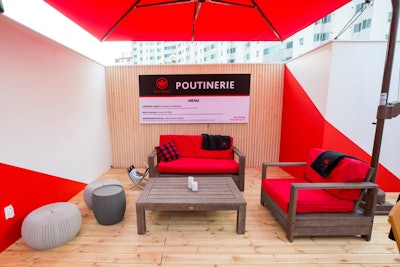
The catering menu included a classic version of the Canadian dish poutine—French fries, cheese curds, and gravy—as well as two Korean-inspired versions.
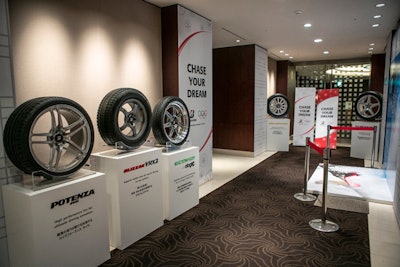
Olympic sponsor Bridgestone hosted more than 150 guests from 10 countries as part of its hospitality program during the games. The tire manufacturer had a showcase at the Shill Hotel in Seoul, which featured tire displays and a winter sports-theme photo op. Bridgestone partnered with Dentsu Korea for the hotel installation.
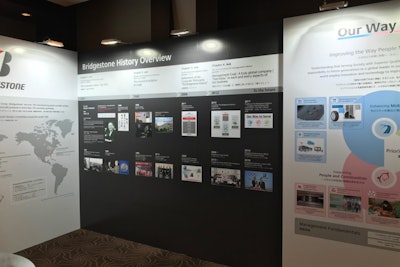
The showcase also included wall that presented history of the company through text and images.




